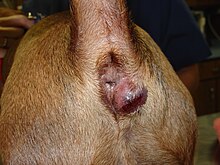Anal gland
The anal glands are glands in close proximity to the anus (anus). They are often located just under the skin near the anus and open with a more or less long duct in the anus or in the skin near the anus.
Classification
According to the localization, these glands can be further divided:
- Anal or Proktodäaldrüsen ( Glandulae anal ): In the mucous membrane of the anal canal lying hose glands which a mucous secretions in the area of Zona columnaris leave the anal canal. In humans these can only be rudimentary or completely absent.
- Anal sac glands ( Glandulae sinus paranales ): glands that pour into a storage space ( anal sac ) located on the side of the anus . They are typical of predators .
- Perianal glands ( Glandulae perianales ): glands in the perineum area , which in guinea pigs pour into an unpaired collecting space below the anus ( perineal pocket ). In rabbits , they are called " sex corners ".
- Circumanal glands ( Glandulae circumanales ): glands around the anal opening, mostly without ducts in dogs .
function
The secretions of the anal glands are submitted according to the species in Kotabsetzen with stripped by rubbing the anus to objects or deliberately molded at glands memory space therefrom. They serve different purposes:
- Formation of an individual odor for mutual identification of the individuals ("anal face")
- Mark the territory
- Signaling of readiness to mate by secreting pheromones
- Defense against enemies; To this end, the foul-smelling secretion can be sprayed in a targeted manner ( skunks )
- For easier excretion of solid manure (as a "lubricant")
Animals with anal glands
Anal glands are common in many animal groups. Sometimes they are not developed in both sexes:
- Many primates including humans
- Almost all carnivores in the canine and feline families have anal glands:
- Rodents
- Lots of snakes
Diseases
If the anal glands and / or their ducts are blocked, inflammation ( cryptitis ) can occur. Infections of the anal glands can lead to abscessing and fistula formation . Also tumors ( adenomas and carcinomas ) of the anal glands may occur. Especially in domestic dogs , adenocarcinomas of the anal sac are feared because they metastasize very early .
Individual evidence
- ^ A b Hans Geyer: Mammary gland. In: Franz-Viktor Salomon et al. (Hrsg.): Anatomie für die Tiermedizin . 2nd ext. Edition. Enke, Stuttgart, 2008, ISBN 978-3-8304-1007-2 , pp. 645-655.
- ^ Anne Schulze: Anatomical peculiarities in rabbits (Oryctolagus cuniculus f. Domestica). In: Franz-Viktor Salomon et al. (Hrsg.): Anatomie für die Tiermedizin . 2nd edition, Enke, Stuttgart, 2008, ISBN 978-3-8304-1075-1 , pp. 726-734.
- ↑ Peter F. Suter, Barbara Kohn, Günter Schwarz: Internship at the dog clinic . 11th edition, Georg Thieme Verlag, Stuttgart 2011, ISBN 978-3-8304-1193-2 , pp. 1136-1137.
